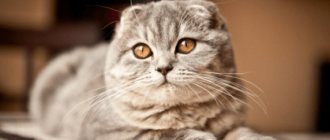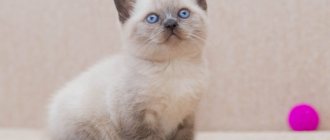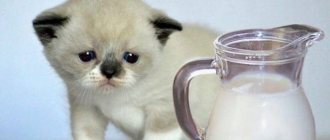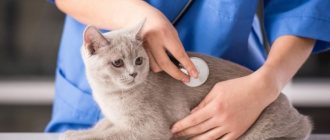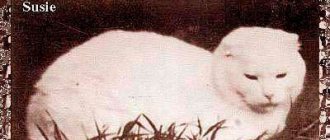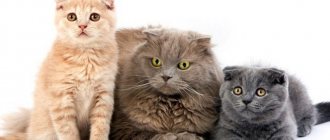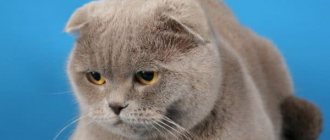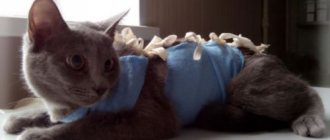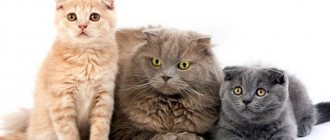Scottish Fold cats have fans all over the world: their small, downturned ears leave no one indifferent. But, unfortunately, it is precisely because of this feature that Scottish Folds are susceptible to osteochondrodysplasia. We will find out what this disease is, how it manifests itself, and we will also look at how to care for a sick cat, what to feed and how to treat it.
Description of the disease
Osteochondrodysplasia in cats (OCD or osteochondrodystrophy) is a genetic malformation of bones and cartilage that leads to slower growth and deformation.
Interesting! Translated from Greek, “osteo” means “bone,” and “dysplasia” means “developmental disorder.”
Osteochondrodysplasia most often affects Scottish Folds, since the disease is directly related to the gene for fold ears. Scots' downturned ears remain this way due to insufficient cartilage formation and disruption of its formation. The lop ear gene is responsible not only for ear deformation, but also for disruption of cartilage formation throughout the body.
Chondrodysplasia usually affects cats' limbs, thoracic, lumbar and caudal vertebrae. This disease can also manifest itself in the form of achondroplasia. With this disease, the cat’s paws cannot grow to normal size, so the pet develops dwarfism.
Osteochondrodysplasia is not life-threatening in most cases, but it can significantly reduce the quality and duration of life.
Osteochondrodysplasia of Scottish cats
A disease associated with the “loop ear” of some cat breeds and leading to disability of the pet. How to recognize it in the early stages? Let's talk about osteochondrodysplasia of Scottish cats.
Translated from Greek, “osteo” means bone, and “dysplasia” means a developmental disorder. OCD is a genetic malformation of cartilage and bone tissue, leading to a slowdown in their growth. The result of this pathology is underdevelopment of the osteochondral system, including the ear cartilage, leading to “loose ears.” The first mention of skeletal deformities in Scottish cats dates back to 1971, although the breed was registered in 1966. The pathology often occurs in offspring when both parents are lop-eared. Scottish cats with straight ears - Scottish Straight and Highland Straight - are not susceptible to osteochondrodysplasia. What makes cats vulnerable to osteochondrodysplasia is the lop-eared gene, which straight cats do not have. However, they can also have deformities of the musculoskeletal system, because The Scottish breed is problematic in this regard. By the way, not only the Scots are considered vulnerable for this trait, but also the Ukrainian Levkoy, in the selection of which Scottish Fold cats were used.
Symptoms of the disease in kittens and cats
The disease can manifest itself in different ways. Owners do not always understand that their pet has problems. Signs that may indicate osteochondrodysplasia:
- Violation of growth and development of kittens. Babies lag behind their healthy brothers and sisters.
- The tail can be shortened, curved, thickened, and inactive.
- Impaired motor function of joints. More often, owners notice problems in the tail, carpal and metatarsal joints.
- Curvature of limbs, deformation of fingers and claws.
- Thickening of the paws, bone growths under the skin located in the heel bone area, ulceration of the growths.
- Lameness.
- Stiff gait.
- Difficulties in jumping up and down from heights.
- Soreness of the limbs.
- Increased vocalization when walking or touching limbs.
- Crooked teeth, overshot, too short nose.
Pathology usually manifests itself in cats at 1.5-2 months. At this age, it is already quite well expressed, since osteoarthritis (degenerative process of bone tissue) has time to develop in the bones. The most typical symptom of OCD is limb deformity. With age, problems only progress.
Diagnostics
The diagnosis is made comprehensively.
The doctor conducts an examination, collects anamnesis, and clarifies the breed of the kitten’s or adult cat’s parents. Without additional diagnostics, it is impossible to make a diagnosis with accuracy, since osteochondrodysplasia can be confused with other pathologies, for example, neoplasia or hypervitaminosis A. Therefore, you will need to take an x-ray, which will show changes in bone and joint tissue. If the doctor still has doubts about the correctness of the diagnosis, then a histological examination of the changed tissues is carried out.
Treatment There is no specific treatment for cats with this pathology. If the process has already started, then the only thing that can be done is to alleviate the animal’s condition. Cats with this problem are prescribed maintenance therapy, which can improve quality of life. However, it does not always improve so much that the pet can at least walk.
Maintenance therapy:
- Since sick cats cannot properly care for their claws, they need to be trimmed, otherwise they can grow into soft tissue. You can do this yourself or by going to a veterinary clinic.
- Do not allow your pet to become obese; excess weight has an extremely negative effect on joints and sore paws. It is recommended to feed cats food to reduce or maintain weight; a plus will be the presence of glucosamine and chondroitin in the composition.
- Chondroprotectors. Not a panacea, but can improve the pet’s quality of life by helping joints.
- If the pain is severe, the veterinarian will prescribe non-steroidal anti-inflammatory drugs to relieve the condition. However, you should not abuse or use it yourself, as it has its own side effects.
In severe cases, surgery (osteotomy and arthrodesis) is indicated. The operation can give very good results if there are indications for it. In some cases, it is still recommended to euthanize the cat. These are cases of a very severe progressive disease with severe pain. If the animal is suffering, cannot lead a normal life, and is constantly on pills, which do not help much.
The importance of choosing a Scottish cat from trusted catteries
Any owner is upset if their pet is sick.
Especially when the disease is incurable and brings suffering. How to avoid the disease? It is recommended to buy a Scottish kitten not from unknown parents, but from trusted breeders, where cats are bred in accordance with all the rules, taking into account the breed characteristics of Scottish cats. When choosing a Scottish breed kitten, pay attention not only to the appearance, fur, ears and eyes, and the baby’s behavior, but also be sure to look at the kitten’s movements: does it run and jump well, is the tail short and has no kinks, is it straight? paws and whether the fingers and claws are correctly formed. Look at both parents of the kitten, their appearance, and whether they are both lop-eared (unacceptable for breeding). To be sure, you can take a veterinarian or felinologist with you to the examination and selection, who will help you choose a healthy kitten.
Causes
Osteochondrodysplasia in cats is inherited. Its manifestation is not related to the gender of the animal.
OCD is considered a disease of Scottish Fold cats, because they are the owners of a mutant gene for fold ears. To avoid the appearance of offspring with osteochondrodysplasia, breeders always cross fold-eared cats with straight-eared cats. In this case, the risk of a dangerous gene appearing is minimal. However, in rare cases, even crossing a straight with a fold may result in a kitten with osteochondrodysplasia. That is why in some countries it is prohibited to breed Scottish Fold cats.
In Scottish Folds, the disease varies in severity. The most common disorders are the development of the bone skeleton, but in the most severe situations, deformation of the limbs can develop.
How can you tell if your cat is sick?
Unfortunately, animals cannot speak, so they will not be able to tell you what exactly is bothering them. The following symptoms may indicate that something is wrong with your cat:
- the animal refuses to communicate and “hides” in a corner; - rapid breathing; - the cat has lost its appetite; - if a cat experiences severe pain, then it cannot tolerate any movement and refuses to be handled; - the animal feels a constant need to scratch, lick, bite, scratch something. Very often she performs such manipulations in the place where she feels acute pain; - discharge from the eyes; — Scottish fold cat constantly runs to the toilet; - Difficulty in eating. The animal may drop food, choke on saliva, etc. If you notice any of these symptoms, contact your veterinarian for help. Before visiting the doctor, you must provide first aid to your cat (if necessary). To do this, you should have a special first aid kit for animals on hand. Never treats Scottish Fold cats with medications intended for humans.
Clinical symptoms
Unfortunately, owners notice signs of osteochondrodysplasia in their pet only when they become pronounced. Main clinical symptoms of the disease:
- lameness;
- head too big;
- crooked teeth;
- stiff gait;
- jaw protruding forward;
- excessively short and flattened nose;
- the appearance of growths on the paws;
- refusal to move and jump;
- the tail is too short and inactive;
- pain during movement;
- twisted and shortened limbs;
- walking on bent legs.
- The base of the tail is too thin.
Important! Osteochondrodysplasia of Scottish Fold cats most often appears at the age of 1.5–2 months. If the gait of a small Scottish Fold is stiff and the tail is motionless, then the kitten is not recommended for purchase.
Symptoms
Signs of the disease: shortened, deformed limbs, very short, thick tail.
The rate of progression, the onset of clinical signs and their severity can vary greatly among animals from different litters. Scottish kittens' ears begin to curl at about 1 month of age, and lameness and difficulty walking associated with osteochondrodysplasia usually appear after the kittens are weaned, at 7 weeks of age or older.
Symptoms of osteochondrodysplasia:
- shortened and deformed legs;
- unnatural, stilted gait;
- lameness in one or more limbs;
- general signs of pain (the kitten meows when stroked, does not play, is inactive, cannot jump or run).
An indirect sign of the disease will be an unnaturally short, thick, straight and rigid tail with a thin base. Due to underdeveloped limbs, the kitten has a “crouched”, squat appearance.
The older the kitten gets, the more difficult it is for him to move. This is due to the fact that the weight of the animal increases, and therefore the load on the damaged joints.
Diagnostic methods
Diagnosis of osteochondrodysplasia in Scottish cats is carried out on the basis of a visual examination, as well as a study of the animal’s pedigree. In addition, to make a final diagnosis, the veterinarian will prescribe the following tests:
- General and biochemical blood test.
- General and biochemical urine analysis.
- X-ray examination of the limbs, spine and tail.
In the image of a cat with osteochondrodysplasia, you can see the deformation of the skeleton, and in the area of the limbs you can detect growths around the joints, while the gaps between them are very narrow. In severe cases of the disease, cartilage tissue is absent, and the vertebrae in the lumbar and caudal regions grow together.
Diagnostics
In order to suspect osteochondrodysplasia in a kitten, an external examination may be sufficient for a veterinarian. But to determine how far the osteoarticular deformation has gone, X-rays are taken.
The most characteristic changes affect the lower limbs, with the hind legs suffering much more than the front legs. An x-ray will show exostoses in the heel area - massive, hard osteochondral growths that resemble a tumor. The bones of the phalanges, metatarsus, and tarsal joints themselves are deformed, and the joint spaces are narrowed or absent.
Treatment
Unfortunately, there is no treatment that would permanently rid a Scottish Fold cat of osteochondrodysplasia. Typically, sick animals are given supportive care to improve their quality of life.
At the initial stage of osteochondrodysplasia, Scottish Folds are usually treated with non-steroidal anti-inflammatory drugs (Ainil, Ketoline, Meloxivet) and chondroprotectors (usually chondroitin sulfate or glucosamine). Such medications stop the destruction of cartilage tissue and increase the amount of joint fluid.
Also, as support for sick pets, manual therapy in combination with massage is prescribed. These procedures improve blood circulation in the animal’s limbs and also help preserve the structure of cartilage tissue. True, they should only be performed by a highly qualified specialist.
In the most severe cases, it may even lead to surgical intervention. Typically, Scottish Fold cats with osteochondrodysplasia undergo the following operations, which give good results:
- Osteotomy. Helps eliminate deformation and improve the performance of the musculoskeletal system, remove growths on bone tissue. For osteotomy, one has to resort to artificially breaking the bones and then connecting them in the required form.
- Arthrodesis. The joint is fixed in an optimal position, after which it gradually ossifies. Mobility in the joint is lost forever, but the support ability of the limb is preserved. Arthrodesis is usually performed if the cat is unable to move or put weight on the affected limb due to severe pain.
Interesting! In Japan and Europe, radiation therapy is used to treat cats with osteochondrodysplasia. It helps reduce pain and slow down the destruction of joints. This method is very effective, but due to the too high cost and lack of necessary equipment in Russian veterinary clinics, it is not yet available.
How to feed sick animals
To improve the quality of life of a Scottish Fold cat with OCD, owners should make their pet’s diet as balanced as possible. It should also contain additives that would help prevent fractures and reduce the rate of cartilage destruction. A Scottish fold cat with osteochondrodysplasia can be fed both natural food and ready-made food, but veterinarians still prefer the first option.
When choosing commercial food, owners need to pay attention to ensure that it is enriched with calcium, phosphorus, iodine, iron, and vitamins E and B. You can also purchase food for your pets that was specially designed for cats with sore joints. Manufacturers additionally introduce glucosamine and chondroitin into them, which, when used in combination, enhance each other’s effects.
When eating a natural diet, it is imperative to include raw meat, sinew and cartilage in the Scots diet.
Important! There is a misconception that Scottish Folds with OCD need to be given jellied meat. However, when boiled, the required amount of nutrients does not remain in the meat and cartilage. In addition, some of them are poorly absorbed by the cat’s body after prolonged cooking.
Owners of sick cats need to remember that such animals are prone to obesity due to a sedentary lifestyle. That is why you will have to constantly monitor the calorie content of the food your pet eats, as well as your pet’s weight, and weigh it regularly. If your cat is overweight, you need to work with your veterinarian to choose a diet for her, because obesity is dangerous not only for the musculoskeletal system, but also for the cardiovascular system.
Life expectancy of cats with OCD
Of course, all owners of Scottish fold cats with osteochondrodysplasia are concerned about the life expectancy of a pet with such a disease. Fortunately, the disease does not directly affect life expectancy. When the first symptoms of OCD appear, owners should take their cat to the doctor as soon as possible. After all, timely treatment can slow down the progression of the disease and improve the pet’s quality of life.
Some veterinarians suggest that owners euthanize a sick pet or amputate the affected limb. However, with good care, supportive care and patience on the part of the owner, the condition of the Scottish Fold cat can be significantly improved. You can also increase your pet's lifespan with a balanced diet.
Unfortunately, if the disease is too severe, it is still better for the animal to undergo euthanasia. It is suggested to do it if the disease is constantly progressing, the pet does not get up at all and does not go to the litter box, and he also has to take pills that no longer bring relief. In such a situation, it is better to stop the cat’s suffering, but the decision always remains with the owner.
Forecasts
The lifespan of Scottish cats affected by osteochondrodysplasia is difficult to predict in advance. It largely depends on how willing the owners are to care for a disabled kitten.
For long-term prognosis, it is necessary to exclude other genetic diseases of Scottish cats, which can occur with irresponsible breeding as often as osteochondrodysplasia. These are polycystic kidney disease and hypertrophic cardiomyopathy, which can be detected using ultrasound.
With mild osteochondrodysplasia, cats can live for years, although they require constant supportive treatment and special housing conditions. For example, they may find it painful to go to the toilet, which leads to urination in the wrong places and chronic constipation.
If the sick kitten is homozygous for the lop-eared gene (both parents are Scottish Folds), the prognosis for life is extremely unfavorable. Bone deformation causes severe pain, which becomes increasingly difficult to relieve with age. The animal cannot move, and at some point the owners resort to euthanasia as a means of ending the suffering of their beloved pet.


